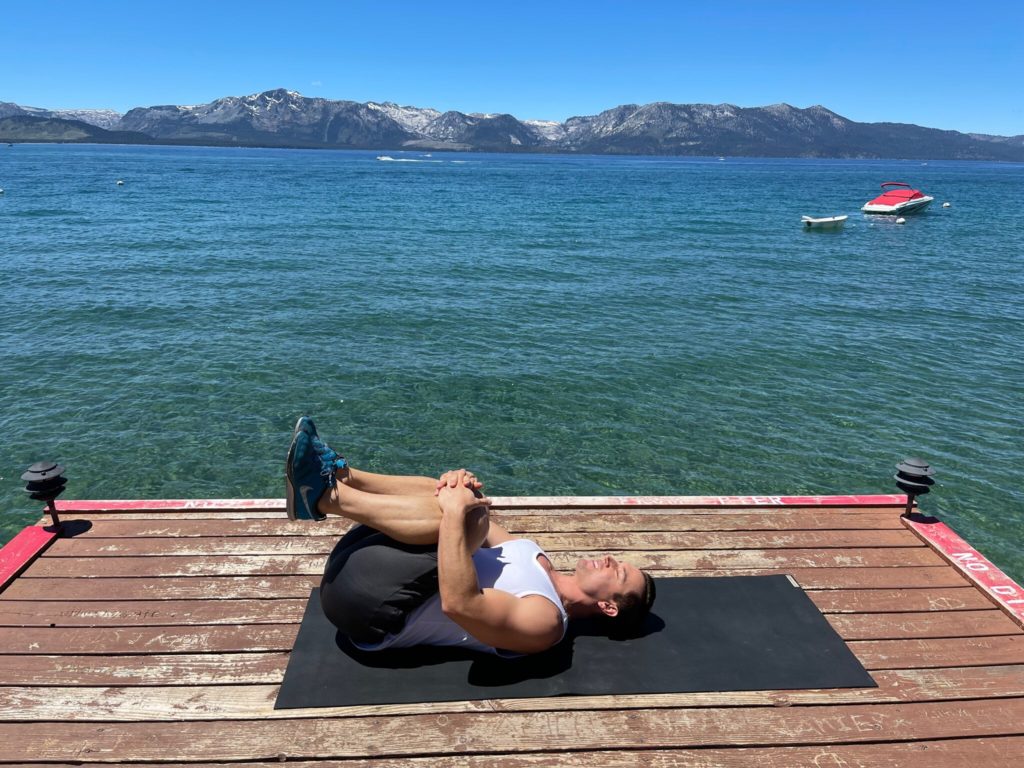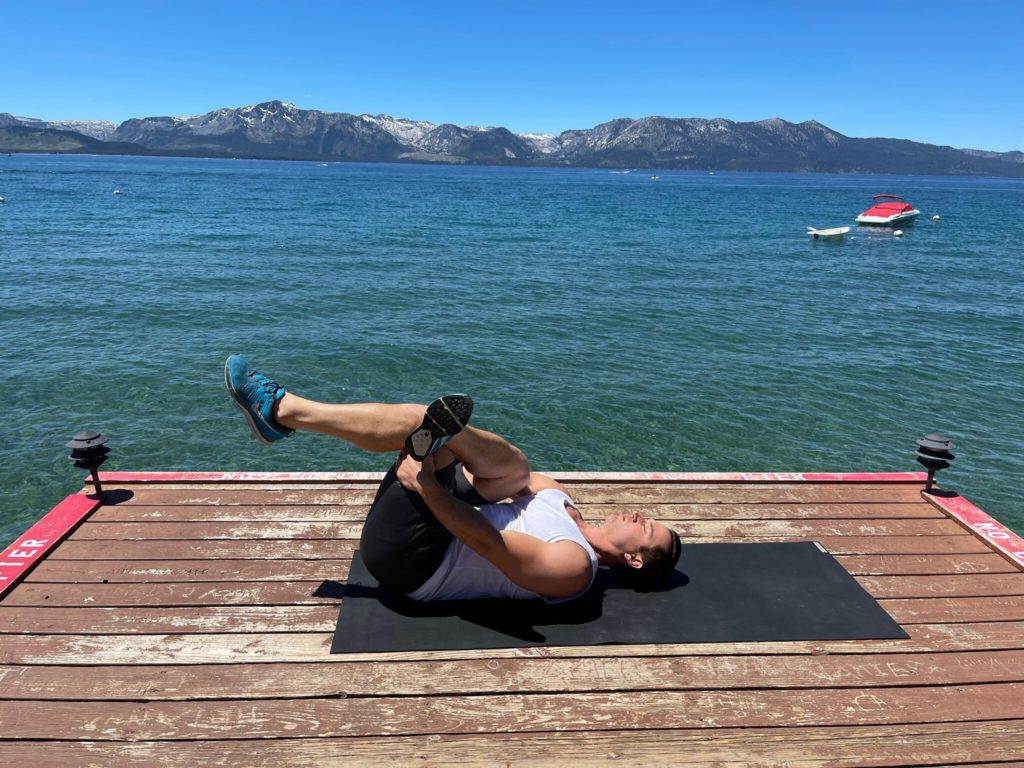Health Report lists down some stretching exercises to help manage sciatica. The instructions for each stretch pose are elaborated through an easy step-by-step guide.
Safety precautions are highlighted to maximize the benefits of stretching. Aside from these stretches, tips on preventing sciatica are also included in this article.
Safety Precautions
- If they are not stretched, muscles may tighten and shorten due to inactivity. Regular stretching improves flexibility and makes the muscles stronger and leaner(1).
- Flexibility from stretching may help prevent injuries and increase one’s range of motion(2). This form of exercise allows the muscles to perform more efficiently and improves physical activity performance(3).
- Some of the stretches that may be done to ease sciatica are standing hamstring stretch, complete back stretch, hip flexor exercise, and seated stretch. These stretches target the glutes and the back muscles.
- Sciatica (sometimes referred to as sciatica nerve pain or simply sciatica pain) is pain from the lower back that radiates to the buttocks and legs(4). This painful condition is often caused by prolonged sitting, obesity, diabetes, or age-related degenerative disorders(5). Many find it so painful they wonder how long does sciatica last?
- For severe sciatica cases, it is best to consult a physician or a physical therapist who can diagnose and treat the painful condition properly.
At Home Stretching Exercises for Immediate Sciatica Pain Relief
People who suffer from the injury or pinching of the sciatic nerve (the largest nerve in the body) starting from the glutes or buttocks often feel electric, burning, or stabbing pain(6). Symptoms may vary, depending on the cause.
Sciatica may be caused by degenerative disc diseases or the natural wearing down of discs in the spinal column, spinal stenosis, and herniated disc(7).
This pain may also be caused by trauma injuries or tumors on the lumbar spine or sciatic nerve(8).
Gentle stretching exercises may reduce low back pain by promoting muscle and joint flexibility(9). This stretching program must involve aerobic and strengthening exercises(10).
Stretching exercises may help relieve low back pain and nerve root compression(11).To ensure safe sciatica stretches, one should avoid bouncing, twisting, or jerking.
Do gentle movements when performing these stretches. Yoga and tai chi for seniors may be applicable in promoting flexibility and reducing fall accidents for the elderly people(12).
Before starting the stretch, individuals should ensure that a simple, light warm-up, like walking, has been done to avoid more severe muscle strains or injuries.
Below are some stretches and poses that may help ease sciatic nerve pain.
People with sciatica should keep in mind that these stretching exercise programs must be done with caution and a medical professional’s assistance.
Standing Hamstring Stretch for Sciatica
This stretch targets the tightness in the hamstring muscles, reducing the risk of lower back pain injuries(13).
To start this stretch, one must:
- Stand in a neutral position with the right foot forward. Then, slightly bend the left knee.
- Flex the right toe upwards and slowly lean forward while placing both hands on the right leg. When bending forward, make sure to keep the back straight and not hunched.
- Hold from 10 seconds up to 30 seconds. Do the same sequence on the left foot and repeat for two to three times in both legs.
Complete Back Stretch

To perform this stretch, one must:
- Assume a lying position with the back flat on the floor. While lying on the floor, put both knees towards the chest and wrap both arms around the knees.
- Hold this position for any preferred duration and try to relax the lower back. Never attempt to crack the spine.
Hip Flexor Exercise
For this hip flexor exercise, one must do the following:
- In a standing position, place one foot in front and make sure that the shoulders are wide apart.
- Gently bend both knees while one foot is in a forwarding position and the opposite knee is lowered to the floor. Pause this position for a moment, then slowly stand from this position and switch legs.
- This exercise may be repeated 10 to 15 times on both sides and performed at least once a day.
Pretzel Stretch
In executing this stretch, one must:
- Lie on the floor with a flat back, and both knees bent.
- Keep both feet on the floor and raise the right ankle on top of the left knee and gently pull the left thigh towards the body.
This stretch is performed to release tension in the pelvic floor and buttocks(14).
Modified Quadricep Stretch
This stretch is recommended to help relax the hips and quadriceps. To get started, one must:
- Start in a prone position by lying flat on the stomach.
- Slowly lift the right leg behind while bending the knee.
- Gently grab the ankle of the right leg with the right hand.
- Slowly pull the right foot towards the body and feel the stretch. One must not pull aggressively as this may result in an injury.
- Do this on the left leg.
Seated Sciatic Nerve Stretch (Sitting pigeon pose)
This stretch is done by sitting on the ground with a stretched-out leg.
To perform the stretch, one must:
- Gently bend the right leg while placing the right ankle on top of the left knee.
- Allow the upper body to stretch as it leans towards the thigh. Hold the stretch position for 15 to 30 seconds before releasing and doing it again on the other side.
- The sitting pigeon pose stretches the lower back and the glutes.
Sitting Spinal Stretch
The sitting spinal stretch is performed by doing the following:
- Start by sitting on the ground with both legs extended straight and the feet flexed upwards.
- Slowly bend the right knee, then put the right foot flat on the floor over the opposite knee.
- Put the left elbow over the right knee and gently turn the upper body on the right side.
- Hold this position for 30 seconds and then switch sides. This stretching position may be done three times.
Piriformis Super Stretch

One can begin this piriformis stretch by doing the following:
- Place both hands and knees on the floor.
- If the sciatica is on the left, turn both legs to the right and extend the right leg backward.
- Meanwhile, if the pain is on the right side, turn both legs to the left, then raise the left leg backward.
- Slowly lower the upper body down to the lowest possible position.
- Maintain a comfortable bend and do not force to lower the torso to the point of pain.
- Hold this stretch for three to five seconds and repeat five to eight times once a day.
This position targets the piriformis muscle to treat piriformis syndrome, one of the causes of sciatica(15).
Piriformis syndrome involves numbness and pain in the glutes or buttocks that run down to the back of the leg. Piriformis pain occurs when the piriformis muscles are pressed on the sciatic nerve.
Knee to the Opposite Shoulder
The knee to the opposite shoulder stretch is done by following these steps:
- One must start by lying down with the back on the floor, and the feet flexed upward. The legs must be extended at the start.
- Then, slowly bend the right leg and grab the right knee with both hands.
- Pull the right leg towards the opposite shoulder and hold for 30 seconds.
- One must gently put the knee back to the starting position, repeat this routine three times, and switch legs.
Best Home Remedies for Sciatica
Several anecdotal home remedies are said to help in managing sciatica. To prevent unnecessary adverse effects, one should seek a healthcare professional’s medical advice before trying the following:
Hot and Cold Compress Application
Some people treat sciatica by simply applying a hot or cold compress to the painful area. This home remedy is done if the cause of sciatica is unknown.
Cold compresses are typically used on the first seven days of sciatic pain(16). In applying a cold compress, one should wrap it first with a cloth before applying it to the skin. Do not directly put the ice pack on the skin to avoid frostbites(17).
Leave the cold compress for 15 to 20 minutes. Make sure to also pause for 15 to 20 minutes between applications.
Meanwhile, a hot compress may be applied when the pain has slightly subsided, and some healing has already occurred(18).
Applying a hot compress may help promote better blood flow to speed up the healing process(19).
People with sciatica should be careful when applying heat, as it may cause burns(20). Ensure that the hot pack is wrapped around a cloth or towel before putting it on the painful area.
Hot compresses can be applied for at least 15 minutes, depending on the pain level. Do not leave the hot compress for more than two hours.
Ice Massage
Doing an ice massage is another way to apply cold therapy to the affected area. In a paper cup, one should put water in and freeze the cup.
Once frozen, the top half of the paper cup should be torn. A cloth should also cover the ice to avoid frostbite. Gently massage the ice on the area affected by sciatica while avoiding the bony parts of the spine.
This massage can be done for ten minutes with an hour interval for each massage.
Medications
Non-steroidal anti-inflammatory drugs (NSAIDs), over-the-counter pain relievers, and muscle relaxants are some of the most common medications used to treat sciatica(21).
Continuous Movement
Bed rest may not be the best way to relieve sciatica(22). Note that sitting for extended periods may increase the risk of sciatica and low back pain(23).
Doing light movements may help increase one’s range of motion and improve flexibility(24). Some of these activities may also strengthen the muscle that supports the spine.
If the pain persists, people with sciatica should visit their doctor to know the proper treatment for this condition.
Tips in Preventing Sciatica
Some causes of sciatica may not be avoided, like pregnancy and degenerative diseases. However, one must follow these tips to help lessen the risk of sciatica and protect the back(25):
Maintain a Good Posture
Good posture helps protect individuals from back pain(26).
Maintaining a good posture keeps the correct alignment of bones and joints while ensuring that the muscles are correctly used(27).
Sitting, standing, lying, and walking with good posture may avoid muscle and back pain. Such a posture decreases the possibility of developing strains or injuries in the spine’s ligaments (28).
Proper alignment of the shoulders, spine, hips, ankles, and knees promotes balance due to evenly distributed body weight(29).
One should maintain a correct sitting position by always sitting up with a straight back, feet comfortably on the floor.
Bend the knees at the right angle or use a footrest if necessary. Do not sit in the same position for longer than 30 minutes.
When standing up, avoid incorrect practices that disrupt the spine’s alignment, such as slouching forward with a rounded upper back and head forward. Instead, stand with the shoulders back.
Do Light Exercises Regularly
Regular exercises and stretching may help in muscle and joint flexibility(30). These exercises must incorporate core and lower back strengthening routines to support the spine.
Individuals should be careful when choosing the exercises and physical activities they do. Pick light, active routines that do not result in back pain.
Tai chi, yoga, swimming, or walking are some of the recommended low-impact activities.
Avoid Falls
To prevent falling accidents, women should avoid wearing high heels. Instead, they should use comfortable shoes and keep the walkways clutter-free to lessen the risk of falls.
Quit Smoking
Smoking makes the vertebral disc and the spine weak because of nicotine, which reduces blood supply to the bones(31).
The weakening of the spine and vertebral disk may increase the risk of back problems due to higher stress levels.
Maintain a Healthy Diet
Avoid a poor diet, which is usually associated with pain and inflammation throughout the body. An average body weight puts less stress and strain on the spine.
When to Consult the Doctor?
Typically, sciatica may last up to four to six weeks(32). However, in some cases, it may last longer.
Individuals experiencing extended periods of pain should consult a doctor for immediate care. These experts help those living with sciatica take the appropriate diagnostic tests and decide which treatment plans are most suitable for the condition.
Physical or chiropractic therapy may be suggested after the diagnosis to help provide pain relief.
However, more research is warranted to verify the benefits of stretching on sciatica and the possible repercussions of these exercises.
The following are some symptoms to look out for to determine if sciatica needs medical attention(33):
- When the cause of pain is an injury or an accident.
- If numbness and severe pain are experienced on the low back or leg.
- If muscle weakness is experienced in the leg.
